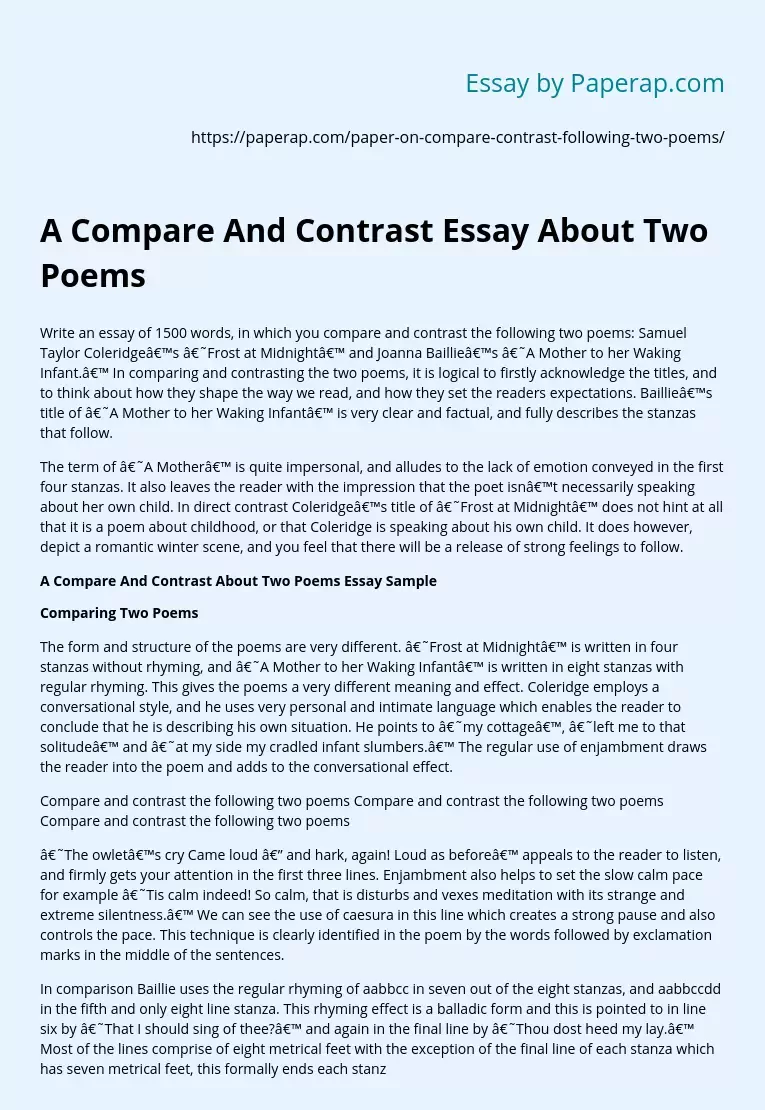A Compare And Contrast Essay About Two Poems
Write an essay of 1500 words, in which you compare and contrast the following two poems: Samuel Taylor Coleridge’s ‘Frost at Midnight’ and Joanna Baillie’s ‘A Mother to her Waking Infant.’ In comparing and contrasting the two poems, it is logical to firstly acknowledge the titles, and to think about how they shape the way we read, and how they set the readers expectations. Baillie’s title of ‘A Mother to her Waking Infant’ is very clear and factual, and fully describes the stanzas that follow.
The term of ‘A Mother’ is quite impersonal, and alludes to the lack of emotion conveyed in the first four stanzas. It also leaves the reader with the impression that the poet isn’t necessarily speaking about her own child. In direct contrast Coleridge’s title of ‘Frost at Midnight’ does not hint at all that it is a poem about childhood, or that Coleridge is speaking about his own child. It does however, depict a romantic winter scene, and you feel that there will be a release of strong feelings to follow.
A Compare And Contrast About Two Poems Essay Sample
Comparing Two Poems
The form and structure of the poems are very different. ‘Frost at Midnight’ is written in four stanzas without rhyming, and ‘A Mother to her Waking Infant’ is written in eight stanzas with regular rhyming. This gives the poems a very different meaning and effect. Coleridge employs a conversational style, and he uses very personal and intimate language which enables the reader to conclude that he is describing his own situation.
He points to ‘my cottage’, ‘left me to that solitude’ and ‘at my side my cradled infant slumbers.’ The regular use of enjambment draws the reader into the poem and adds to the conversational effect.
Compare and contrast the following two poems Compare and contrast the following two poems Compare and contrast the following two poems
‘The owlet’s cry Came loud — and hark, again! Loud as before’ appeals to the reader to listen, and firmly gets your attention in the first three lines. Enjambment also helps to set the slow calm pace for example ‘Tis calm indeed! So calm, that is disturbs and vexes meditation with its strange and extreme silentness.’ We can see the use of caesura in this line which creates a strong pause and also controls the pace. This technique is clearly identified in the poem by the words followed by exclamation marks in the middle of the sentences.
In comparison Baillie uses the regular rhyming of aabbcc in seven out of the eight stanzas, and aabbccdd in the fifth and only eight line stanza. This rhyming effect is a balladic form and this is pointed to in line six by ‘That I should sing of thee?’ and again in the final line by ‘Thou dost heed my lay.’ Most of the lines comprise of eight metrical feet with the exception of the final line of each stanza which has seven metrical feet, this formally ends each stanza and leaves the reader to think about the meaning of the poem. The regular rhyming also controls the pace of the poem and helps to command the way we read. Poetic inversion is evident in the first stanza with, ‘lip awry’ and ‘chrystal spread’ which serves to maintain the consistent rhyming scheme.
Baillie does not seem to identify with the feelings that belong to a parent; this is demonstrated by the lack of emotional language and empathy in the first four stanzas, like ‘helpless thing! What do I see’ and ‘shapeless limbs nor step nor grace.’ Her descriptions could be of any baby, and are quite ordinary and matter of fact. There does however seem to be a turning point in the fifth eight line stanza. Her language becomes softer with the use of ‘warm, grace and kindness’. The infant described by colours ‘ rosy cheek’, ‘pinky hand’, and ‘gold tipped ends’ brings the poem alive and the reader is at last presented with some powerful, vibrant images. The additional two lines indicate the turning point in the poem too.
A Compare And Contrast Essay About Two Poems. (2019, Dec 05). Retrieved from https://paperap.com/paper-on-compare-contrast-following-two-poems/

